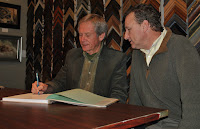I had such a great afternoon Sunday!
I remember exactly where I was sitting when I saw the first painting by Robert Bateman. Say what you will – it ranks up there with all the events that have jolted my senses into full engagement – you know – those that make such an impact that you remember the day, the place, the situation you were in when it happened, the death of Lady Dianna, 911... Of course this was not an experience that signalled a shift in the course of world history. It was a delightful experience that moved something inside of me.
I was sitting on the daybed, which was where I slept when Wilmien and I visited her parents - my future in-laws, on their farm in South Africa. I was flipping through a Reader’s Digest in the dimly-lit living room of the then +/- 100 year old red mud brick farm house which has since been completely modernized. There was one small window in the room, no electricity and therefore no TV, just untold hours of outdoor activities and piles of books to read on rainy days and lamp-lit evenings. I was a first year student at the Pretoria Tech Art School. I have been into wildlife and art since I can remember, but when I read the article about this Canadian artist and saw his painting “Winter Cardinal” something welled up inside of me. It was the moment I said to myself, “this is what I want to do!” If I remember correctly Bateman’s first run in with Andrew Wyeth’s work did the same for him.
When Dan Schutlz was teaching his workshop here, I took him to some galleries, one of them was Art Country Canada in Bragg Creek. A notice on the door said Robert Bateman would be there on October 31, so today I had the privilege of meeting Robert Bateman. As he signed his most recent book, BATEMAN NEW WORKS for me, I told him about that experience on the farm in the few moments we had. He seemed genuinely interested. I thanked him for the influence his work has had on the formation of my ideas about art, nature and the awareness he brings to conservation. I also got him to sign my book with a message to my old art-school friend Jack Swanepoel which says, “Jack, I’m no longer jealous!” He was curious. “You really want me to put that?” He asked in a way that begged an explanation so I thought I’d tell him the story...
The first art show I went to after we moved to Canada was one by John Seerey – Lester. I got good Mr John to sign me a brochure he had on hand with the inscription, “Jack, this is to make you jealous!” Jack and I share a love of wildlife art and nature and because South Africa is so far off the beaten track as far as exposure to world class artists is concerned, I just wanted him to know that they were “all around me now like flies on a rhino midden.” Sometime later I got a package from Jack with a brochure about the work in Robert Bateman’s show at the Everard Read Gallery in Johannesburg and an inscription; “Hermann, this is to make YOU jealous!” signed Robert Bateman.
Here I am relaying the exchange of jealousies between me and my friend Jack. I think you'll agree - he was amused.
I know some people don’t appreciate Bateman’s art. I am aware of the ongoing criticism of Bateman’s work and marketing methods by the “art establishment” whomever or whatever they or that really is - but I don’t care – I like his stuff. I like a lot of different kind of art - but what impressed me this afternoon was to see that Robert Bateman is far more than an artist. I’d say most artists are just that – artists. That’s not a bad thing. There might be an interest in things beyond their work, but Bateman’s art has become a platform of expression for a heart that beats for the great social, environmental and spiritual issues of the world. As I stood there, listening to him speak, I felt something resonate within me once again.
Thankfully there is no such thing as the world’s greatest artist, so for those who spend the time to gain a reputation for good, consistent and meaningful work in their chosen medium and subject matter, they have the choice to either be in it for what art can do for them or to use their gift as a platform from which to proclaim a message of much greater significance than their paintings may ever achieve. I am a firm believer that one person can make a difference.
Thankfully there is no such thing as the world’s greatest artist, so for those who spend the time to gain a reputation for good, consistent and meaningful work in their chosen medium and subject matter, they have the choice to either be in it for what art can do for them or to use their gift as a platform from which to proclaim a message of much greater significance than their paintings may ever achieve. I am a firm believer that one person can make a difference.
Thanks Robert Bateman – who knows how many other lives your work, seen in dimly lit farmhouses in obscure places across the world have influenced. I came away this afternoon thinking, if allowed the chance, I don’t just want to make paintings – I want to make a difference.
So here’s to the importance of “place;” of belonging, which facilitates passionate, personal action and to the measureless imagination and beauty of God and His creation, which, as you said, has the power to change human lives if we will allow ourselves to be saturated by it.

























